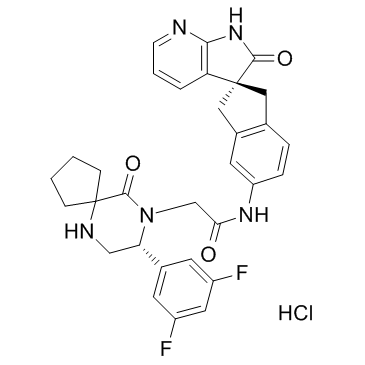957116-20-0
| Name | MK 3207 hydrochloride |
|---|---|
| Synonyms |
(8R)-8-(3,5-Difluorophenyl)-10-oxo-N-[(2R)-1,1',2',3-tetrahydro-2'-oxospiro[2H-indene-2,3'-[3H]pyrrolo[2,3-b]pyridin]-5-yl]-6,9-diazaspiro[4.5]decane-9-acetamide hydrochloride
MK-3207 HCl MK 3207 HCl MK-3207 (Hydrochloride) |
| Description | MK-3207 (Hydrochloride) is a potent and orally bioavailable CGRP receptor antagonist with IC50 of 0.12 nM and Ki of 0.024 nM, and is highly selective versus human AM1, AM2, CTR, and AMY3. |
|---|---|
| Related Catalog | |
| Target |
IC50: 0.12 nM (CGRP receptor) |
| In Vitro | MK-3207 displays a similar affinity (Ki) for the rhesus monkey receptor (0.024±0.001 nM; n=14) as for human, but it displays >400-fold lower affinity for the canine and rat receptors, with values of 10 nM and 10±1.2 nM, respectively. MK-3207 is highly selective versus the human AM1 (CLR/RAMP2) and AM2 (CLR/RAMP3) receptors, with Ki values of 16,500 nM and 156±17 nM, respectively. MK-3207 maintains a high degree of selectivity versus human CTR, with a Ki value of 1.9±0.58 μM. MK-3207 also displays good selectivity versus the AMY3 (CTR/RAMP3) receptor, with a Ki value of 128±25 nM, but it is less selective versus the AMY1 (CTR/RAMP1) receptor, with a Ki value of 0.75±0.13 nM. MK-3207 potently blocks human α-CGRP-stimulated cAMP responses in human CGRP receptor-expressing HEK293 cells, with an IC50 value of 0.12±0.02 nM. MK-3207 displays significantly lower potency for the rat CGRP receptor, with a pIC50=7.31±0.09[1]. |
| In Vivo | MK-3207 is CNS-penetrant and therefore significantly engaging central receptors. After an oral dose of 10 mg/kg MK-3207, the CSF/plasma ratio is 2 to 3%[1]. |
| Kinase Assay | Amylin binding assays are conducted by combining MK-3207 and 40 pM 125I-rat amylin, followed by 25 μg of CTR/RAMP1 or 25 μg of CTR/RAMP3 membranes and incubated for 3 h at room temperature in binding buffer (10 mM HEPES, 5 mM MgCl2, and 0.2% bovine serum albumin) in a total volume of 1 mL. Calcitonin binding assays are with 25 μg of CTR membranes and 30 pM 125I-human calcitonin as the radioligand. Incubations are terminated by filtration through GF/B 96-well filter plates that has been blocked with 0.5% polyethylenimine. Data are analyzed using Prism, and the Ki value is determined using the equation Ki=IC50/1 + ([ligand]/KD). The KD value for each receptor is determined by saturation binding experiments. |
| Animal Admin | A customized flexible silicone catheter is freely suspended in the cisterna magna, anchored firmly on both sides of the atlanto-occipital membrane, and tunneled subcutaneously to the midscapular region where it is fed into a surgically implanted port body. CSF is accessed by aseptically inserting a needle through the skin and membrane covering the port into the reservoir of the port body; blood samples are collected by peripheral venipuncture. After oral administration of MK-3207 at 10 mg/kg (0.5% methylcellulose, with an adjusted pH appr 3) to cisterna magna catheter and port-implanted rhesus monkeys, CSF and plasma samples are collected at 0.5, 1, 2, 4, 8, and 24 h and analyzed for compound levels. |
| References |
| Molecular Formula | C31H30ClF2N5O3 |
|---|---|
| Molecular Weight | 594.051 |
| Exact Mass | 593.200500 |
| PSA | 103.43000 |
| LogP | 5.05260 |
| Storage condition | -20℃ |
